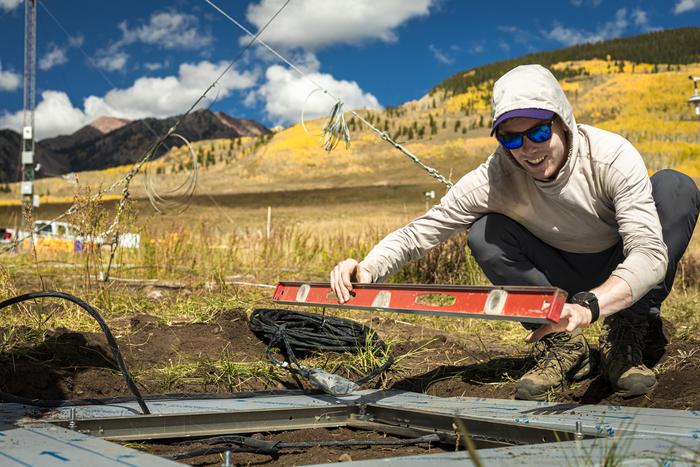The Colorado River and its tributaries provide water for hydropower, irrigation and drinking water in seven U.S. states and Mexico. Much of this water comes from the snowpack that builds up over the winter and then melts each spring. Every year in early April, water managers use the snowpack to predict how much water will be available for the upcoming year.

Credit: Mark Stone/University of Washington
The Colorado River and its tributaries provide water for hydropower, irrigation and drinking water in seven U.S. states and Mexico. Much of this water comes from the snowpack that builds up over the winter and then melts each spring. Every year in early April, water managers use the snowpack to predict how much water will be available for the upcoming year.
But since 2000, these predictions have been incorrect, with the actual streamflow being consistently lower than the predicted streamflow. That’s left water managers and researchers flummoxed — where’s the water going?
The problem lies with the lack of rainfall in the spring, according to new research from the University of Washington. The researchers found that recent warmer, drier springs account for almost 70% of the discrepancy. With less rain, the plants in the area rely more on the snowmelt for water, leaving less water to make its way into the nearby streams. Decreased rain also means sunny skies, which encourages plant growth and water evaporation from the soil.
The researchers published these results Aug. 16 in Geophysical Research Letters.
“The period of time when we were wondering, ‘Oh no, where’s our water going?’ started around the same time when we saw this drop in spring precipitation — the beginning of the ‘Millennium drought,’ which started in 2000 and has been ongoing to the current day,” said lead author Daniel Hogan, a UW doctoral student in the civil and environmental engineering department. “We wanted to focus on the cascading consequences of this. Less springtime rain means you likely have fewer clouds. And if it’s going to be sunny, the plants are going to say, ‘Oh, I’m so happy. The snow just melted and I have a ton of water, so I’m going to grow like gangbusters.’ This research really centers the importance of studying the whole snow season, not just when the snowpack is the deepest.”
Hogan and senior author Jessica Lundquist, a UW professor of civil and environmental engineering, studied this phenomenon as part of a bigger project to solve the big “whodunit” of where the water is going. At first, the researchers wondered if the snowpack was decreasing because the snow was simply turning into water vapor — a process called sublimation. But the team recently discovered that only 10% of the missing water was lost due to sublimation, meaning something else was the main culprit.
“There are only so many possible culprits, so I started to compare things that might be important,” Hogan said. “And we saw that springtime changes are a lot more exaggerated than they are in other seasons. It’s this really dramatic shift where you’re going from feet of snowpack to wildflowers blooming over a very short amount of time, relatively speaking. And without spring rains, the plants — from wildflowers to trees — are like giant straws, all drawing on the snowpack.”
The researchers looked at springtime changes in 26 headwater basins at various elevations in the Upper Colorado River Basin. To paint a picture of what was happening at each basin over time, the team used a variety of datasets, including streamflow and precipitation measurements dating back to 1964. The researchers then modeled how much water the plants at each basin would likely consume.
“We make an important assumption in the paper,” Hogan said. “We assume that the plants have an unlimited amount of water even with less-than-average precipitation, because they have access to snowmelt.”
All the basins the team studied showed reduced streamflow without springtime rain. But basins at lower elevations had an even more pronounced deficit in streamflow. This is because the snow at these basins is likely to melt earlier in the season, giving the plants more time to grow and consume the snowmelt, the researchers said.
Now that spring rain has been identified as the main culprit, the researchers are working to further refine their understanding of what’s happening during this season. For example, one project is investigating whether residual patches of snow are acting as mini-reservoirs that can provide a constant stream of water to nearby plants.
Regardless, the longer the Millennium drought continues, the more these results will affect the water calculations that happen each April.
“April is when everybody wants to know how much water is in the snowpack each year,” Lundquist said. “But the problem with doing these calculations in April is that obviously spring hasn’t occurred yet. Now that we know spring rain is actually more important than rain any other times of the year, we’re going to have to get better at predicting what’s going to happen rainwise to make these April predictions more accurate.”
This research was funded by the National Science Foundation, the Sublimation of Snow Project and the Department of Energy Environmental System Science Division (the Seasonal Cycles Unravel Mysteries of Missing Mountain Water project).
Journal
Geophysical Research Letters
Article Title
Recent Upper Colorado River Streamflow Declines Driven by Loss of Spring Precipitation
Article Publication Date
16-Aug-2024



